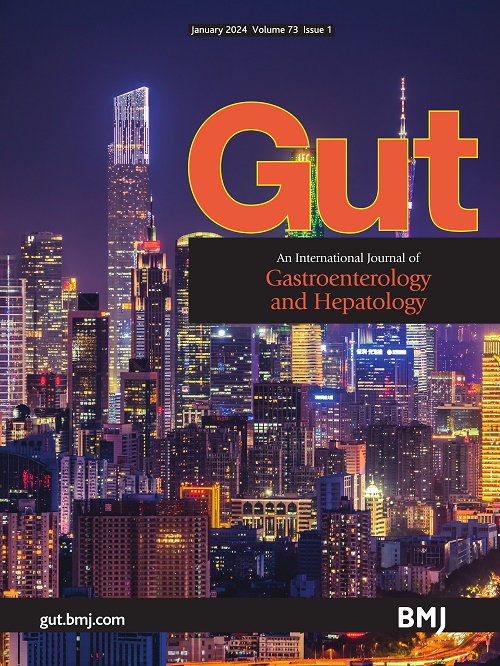Endothelial-like cancer-associated fibroblasts facilitate pancreatic cancer metastasis via vasculogenic mimicry and paracrine signalling
IF 25.8
1区 医学
Q1 GASTROENTEROLOGY & HEPATOLOGY
引用次数: 0
Abstract
Background Cancer-associated fibroblasts (CAFs) are highly heterogeneous in the progression of pancreatic ductal adenocarcinoma (PDAC) and vasculogenic mimicry (VM) refers to a phenomenon in which cancer cells adopt endothelial-like characteristics. Objective To identify a novel protumoural CAF subtype undertaking VM. Design We used single-cell RNA sequencing and mIHC to identify FAPα+CD144+ endothelial-like CAFs (endoCAFs) and combined prospective and retrospective analyses to assess its clinical outcomes. Tube formation, proliferation and invasion assay were conducted on cell lines, organoids, the orthotopic tumour model and LSL-KrasG12D/+, LSL-Trp53R172H/+ and Pdx1-Cre (KPC) mouse model. Mechanically, we performed cytokine array assays, RNA-sequencing, IP-mass spectrometry, ChIP and luciferase analyses. Importantly, an siRNA delivery nanosystem was developed to precisely target FAPα+CD144+endoCAFs in vivo. Results FAPα+CD144+endoCAFs were present in the tumour microenvironment of PDAC, and patients with a higher CD144+CAFs proportion displayed poor prognosis of PDAC. FAPα+CD144+endoCAFs not only acquired a VM phenotype to provide metastatic conduits but also promoted the proliferation and invasion of tumour cells in situ through paracrine signalling, thereby actively facilitating the metastasis of tumour cells. The CD144-β-catenin-STAT3 signalling axis was activated, and CD144 and downstream secreted cytokines were transcriptionally upregulated to maintain the dual roles of endoCAFs. A CAF-targeting siRNA delivery nanosystem, via loading FAPα and siCD144, was administered to precisely target FAPα+CD144+ endoCAFs, which substantially inhibited their protumoural roles in vivo. Conclusion FAPα+CD144+endoCAFs can promote metastasis of PDAC via undertaking VM and paracrine through activation of the CD144-β-catenin-STAT3 signalling axis. CAF-targeting siRNA delivery nanosystem can inhibit tumour progression by precisely targeting FAPα+CD144+endoCAFs. Data are available on reasonable request. The data analysed in this research were obtained from EBI Arrayexpress (内皮样癌相关成纤维细胞通过血管生成模拟和旁分泌信号传导促进胰腺癌转移
背景 癌症相关成纤维细胞(CAFs)在胰腺导管腺癌(PDAC)的进展过程中具有高度异质性,而血管生成模拟(VM)是指癌细胞具有内皮样特征的一种现象。目的 鉴别一种新型原发肿瘤CAF亚型,以进行VM。设计 我们使用单细胞RNA测序和mIHC鉴定FAPα+CD144+内皮样CAFs(endoCAFs),并结合前瞻性和回顾性分析评估其临床结果。我们在细胞系、器官组织、正位肿瘤模型和 LSL-KrasG12D/+、LSL-Trp53R172H/+ 和 Pdx1-Cre (KPC) 小鼠模型上进行了管形成、增殖和侵袭试验。在机制上,我们进行了细胞因子阵列测定、RNA 序列测定、IP-质谱分析、ChIP 和荧光素酶分析。重要的是,我们开发了一种 siRNA 纳米递送系统,可在体内精确靶向 FAPα+CD144+endoCAFs。结果 FAPα+CD144+endoCAFs 存在于 PDAC 的肿瘤微环境中,CD144+CAFs 比例较高的 PDAC 患者预后较差。FAPα+CD144+endoCAFs不仅获得了VM表型,提供了转移管道,还通过旁分泌信号促进了肿瘤细胞在原位的增殖和侵袭,从而积极促进了肿瘤细胞的转移。CD144-β-catenin-STAT3信号轴被激活,CD144和下游分泌细胞因子转录上调,以维持内CAF的双重作用。通过装载 FAPα 和 siCD144 的 CAF 靶向 siRNA 递送纳米系统,可精确靶向 FAPα+CD144+ 内皮癌细胞,从而大幅抑制其在体内的原发肿瘤作用。结论 FAPα+CD144+endoCAFs 可通过激活 CD144-β-catenin-STAT3 信号轴,通过承接 VM 和旁分泌促进 PDAC 转移。CAF靶向siRNA递送纳米系统可通过精确靶向FAPα+CD144+endoCAFs抑制肿瘤进展。如有合理要求,可提供相关数据。本研究分析的数据来自EBI Arrayexpress()的E\_MTAB\_6134和The Cancer Genome Atlas (TCGA)-Pancreatic Adenocarcinoma (PAAD) cohort by GEPIA 2()。所有其他原始数据可向通讯作者索取。
本文章由计算机程序翻译,如有差异,请以英文原文为准。
求助全文
约1分钟内获得全文
求助全文
来源期刊

Gut
医学-胃肠肝病学
CiteScore
45.70
自引率
2.40%
发文量
284
审稿时长
1.5 months
期刊介绍:
Gut is a renowned international journal specializing in gastroenterology and hepatology, known for its high-quality clinical research covering the alimentary tract, liver, biliary tree, and pancreas. It offers authoritative and current coverage across all aspects of gastroenterology and hepatology, featuring articles on emerging disease mechanisms and innovative diagnostic and therapeutic approaches authored by leading experts.
As the flagship journal of BMJ's gastroenterology portfolio, Gut is accompanied by two companion journals: Frontline Gastroenterology, focusing on education and practice-oriented papers, and BMJ Open Gastroenterology for open access original research.
 求助内容:
求助内容: 应助结果提醒方式:
应助结果提醒方式:


